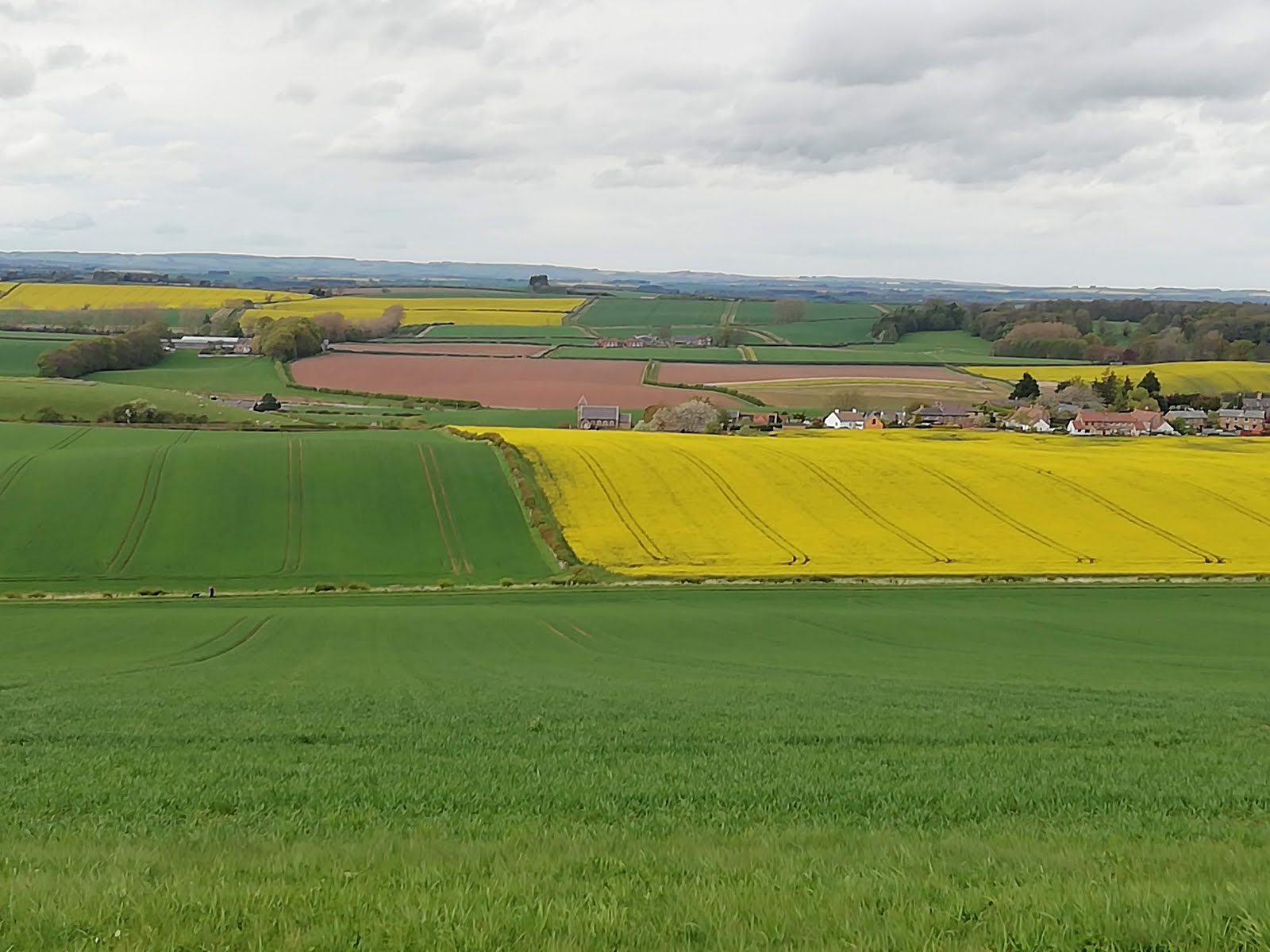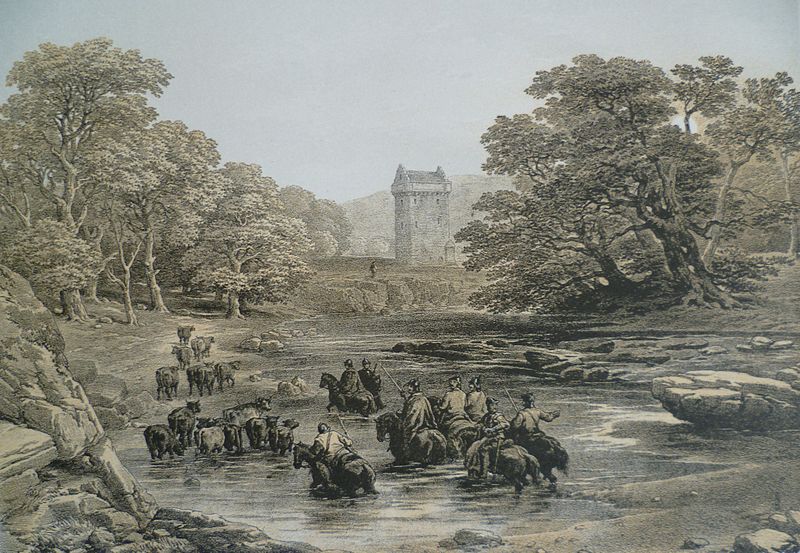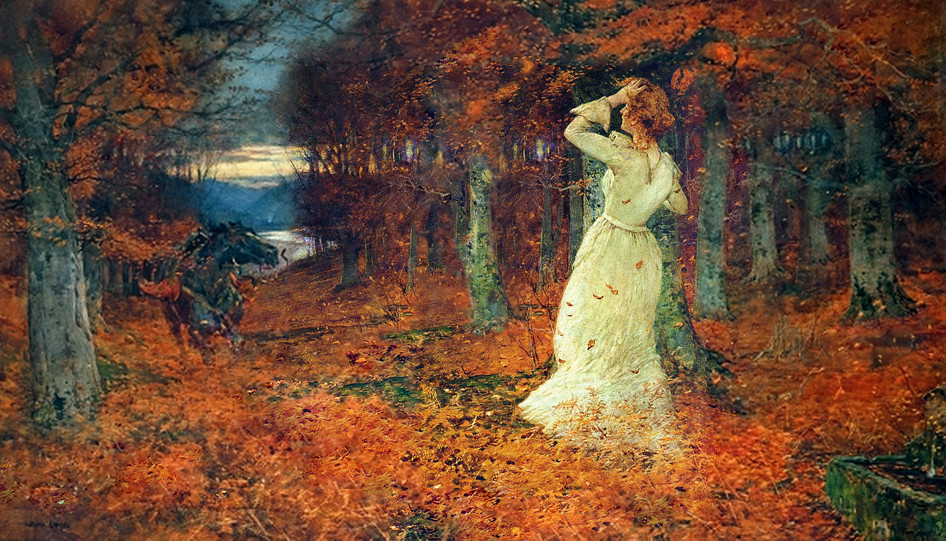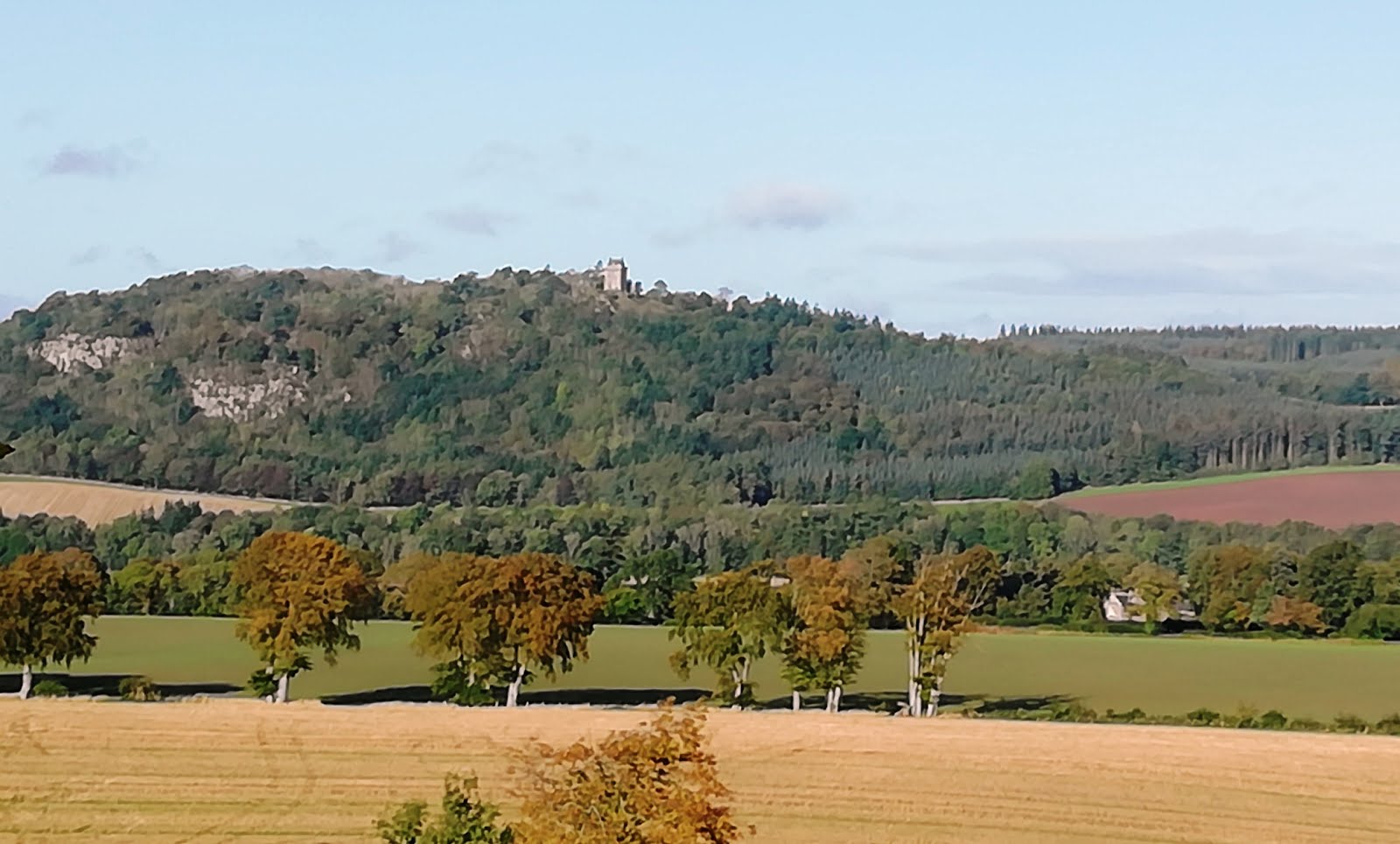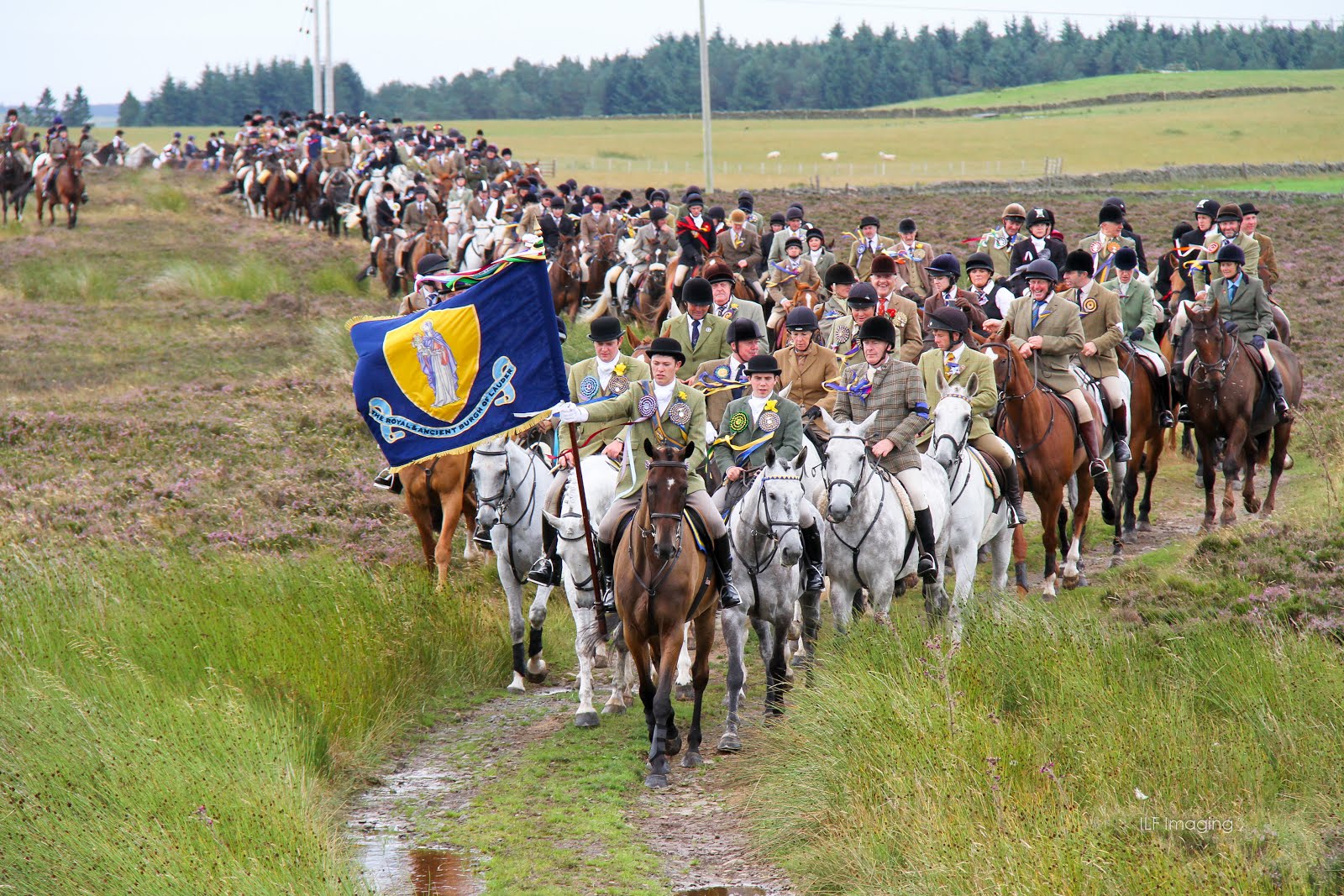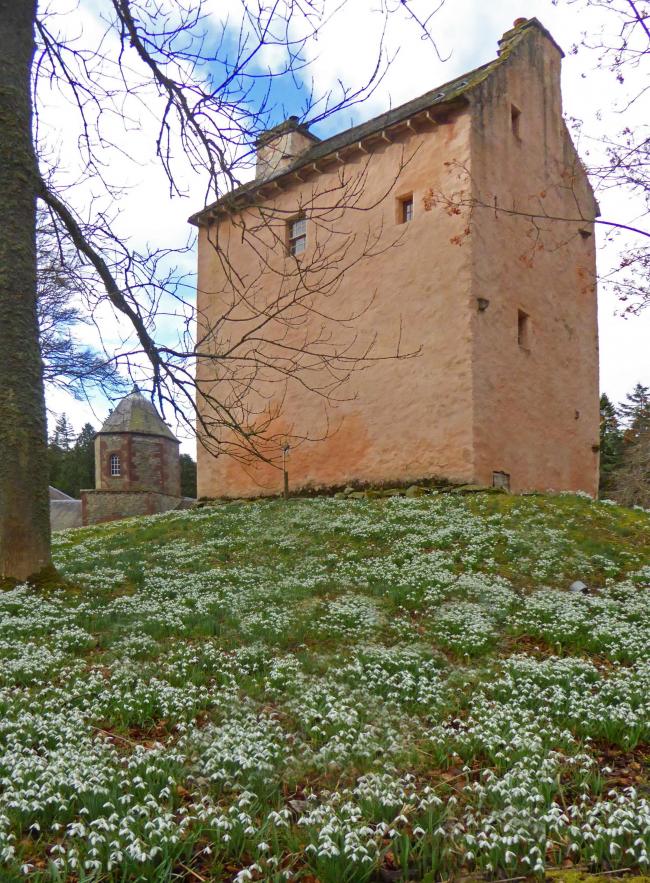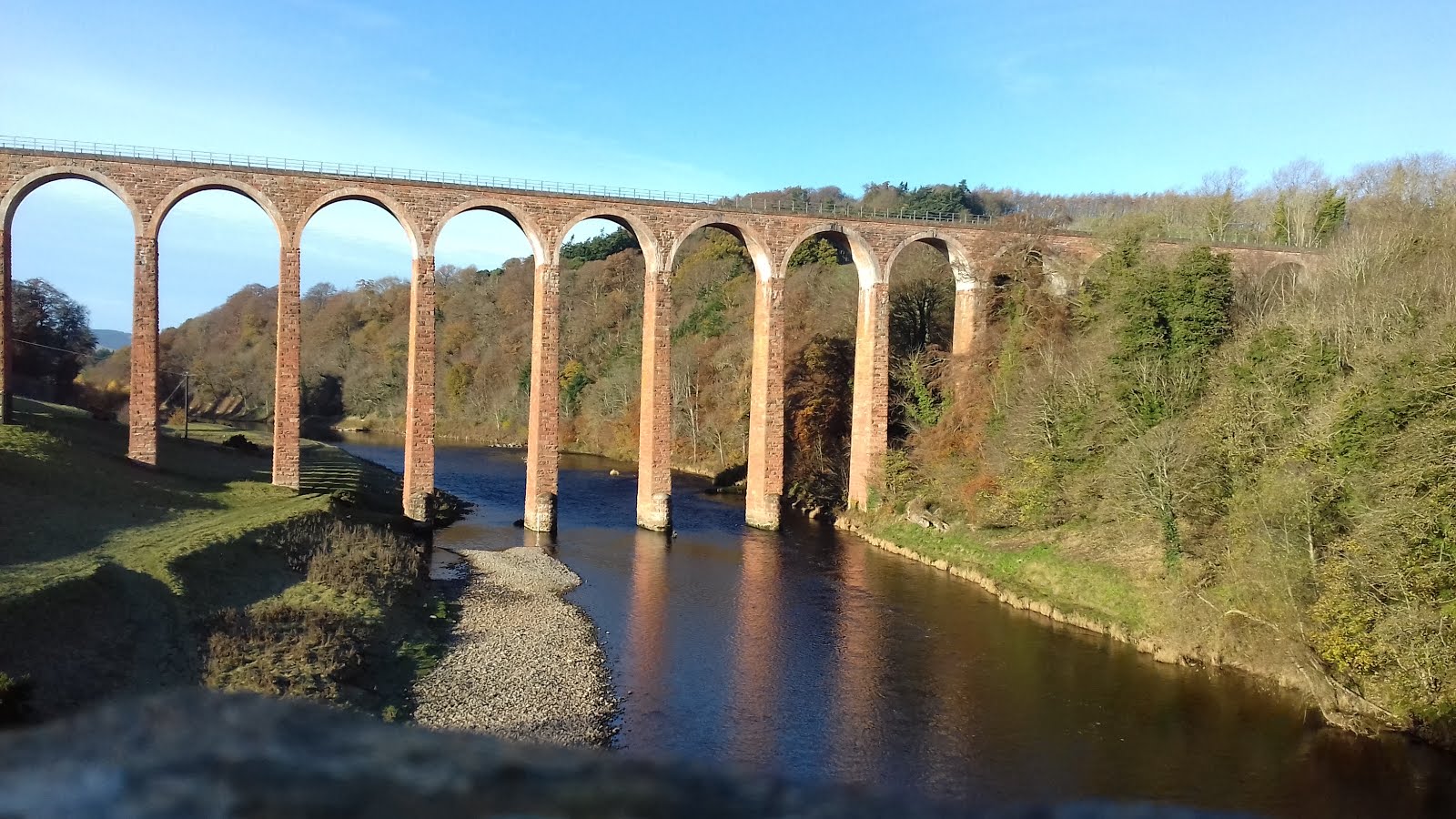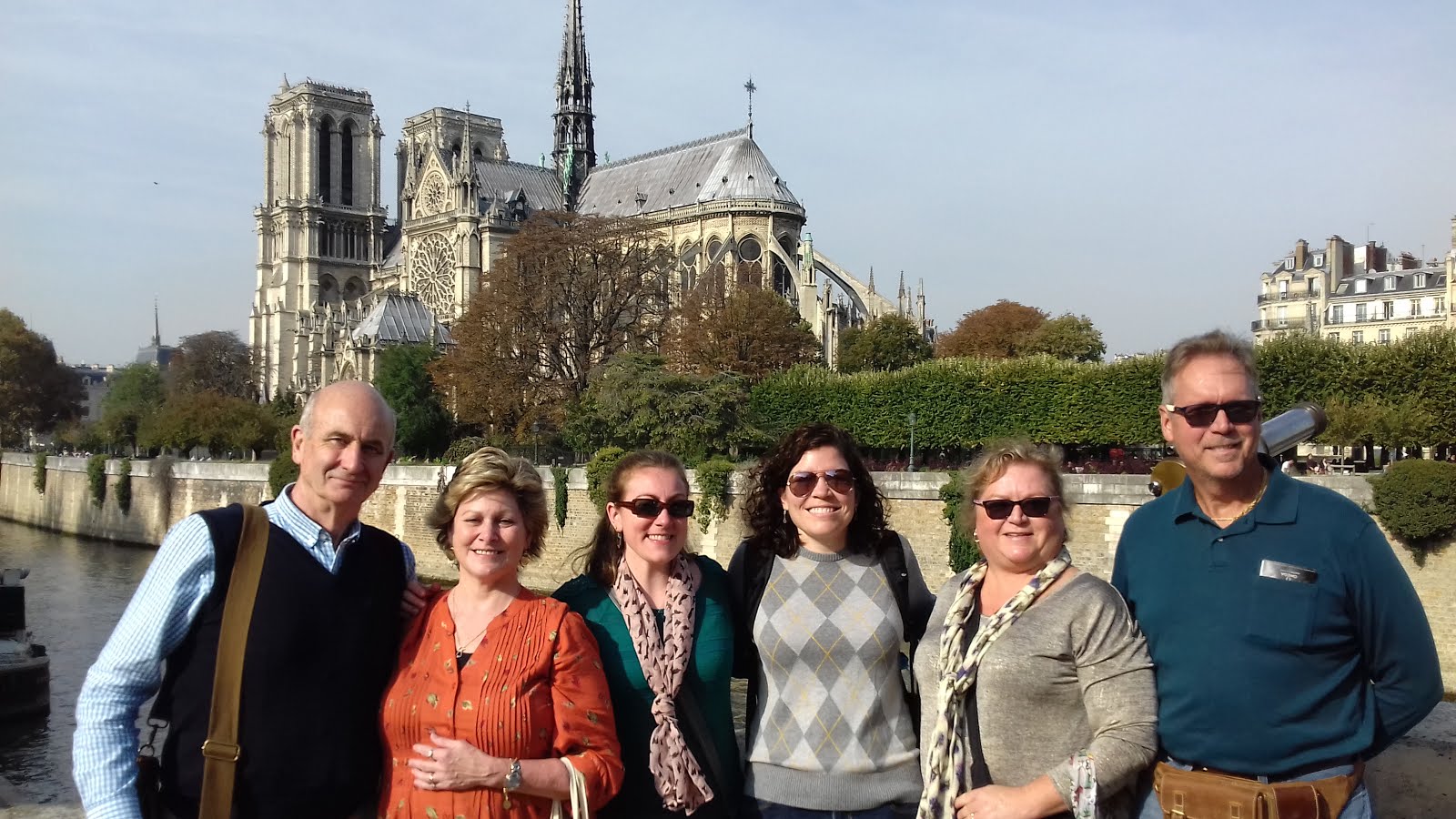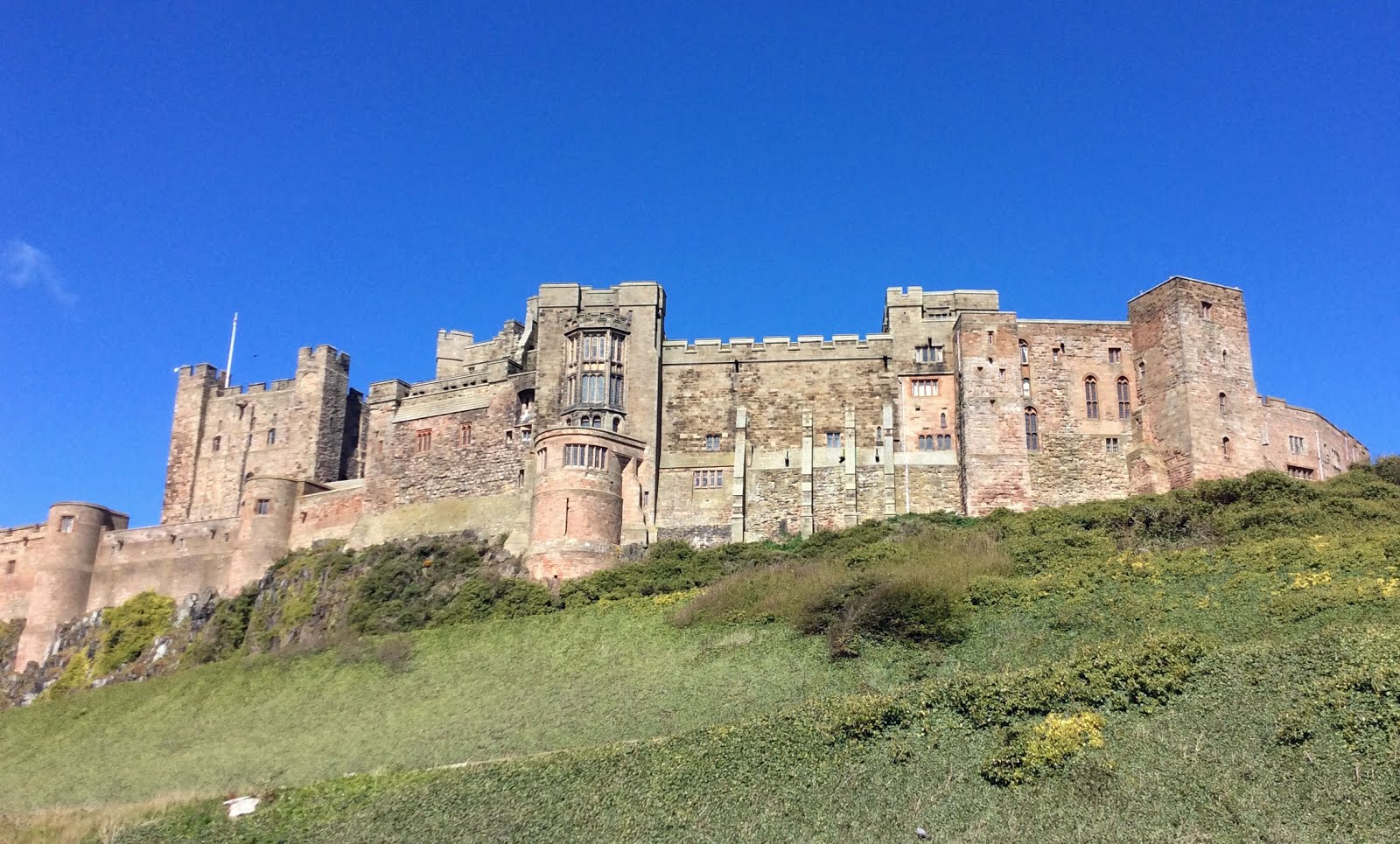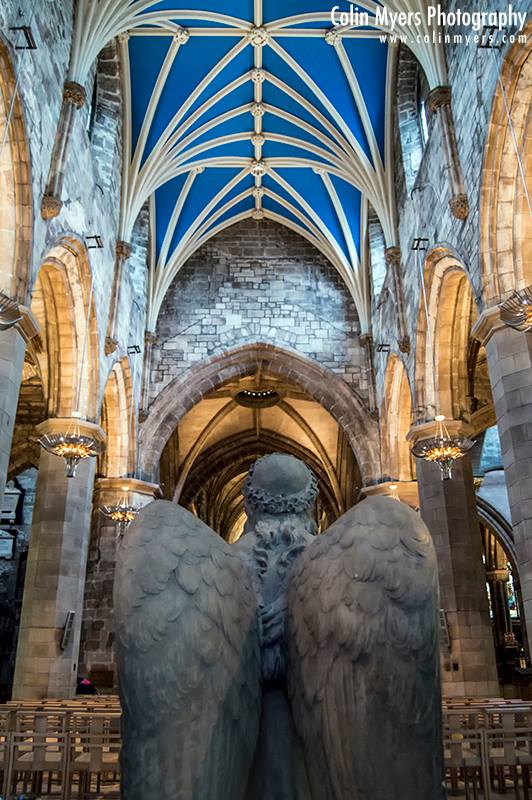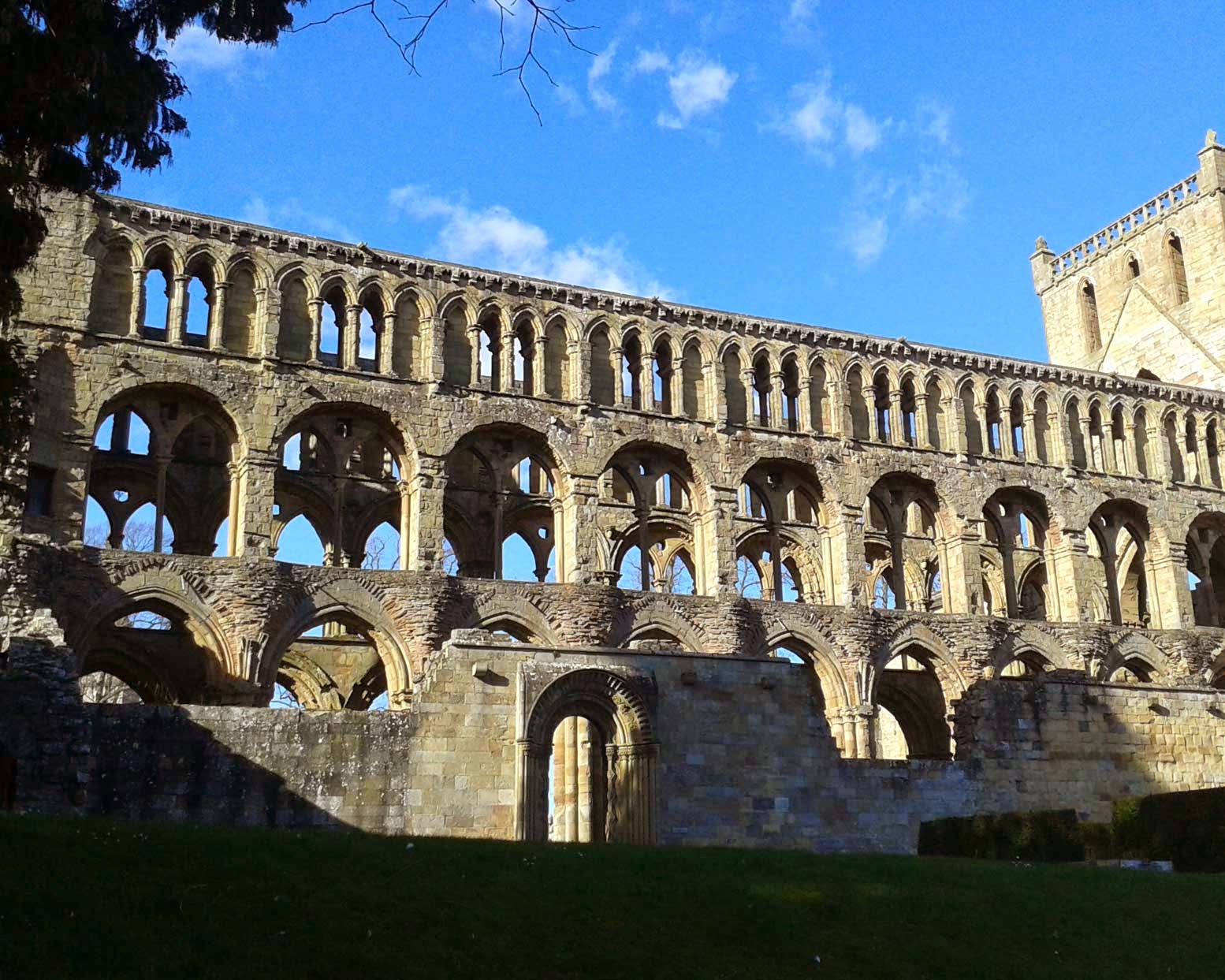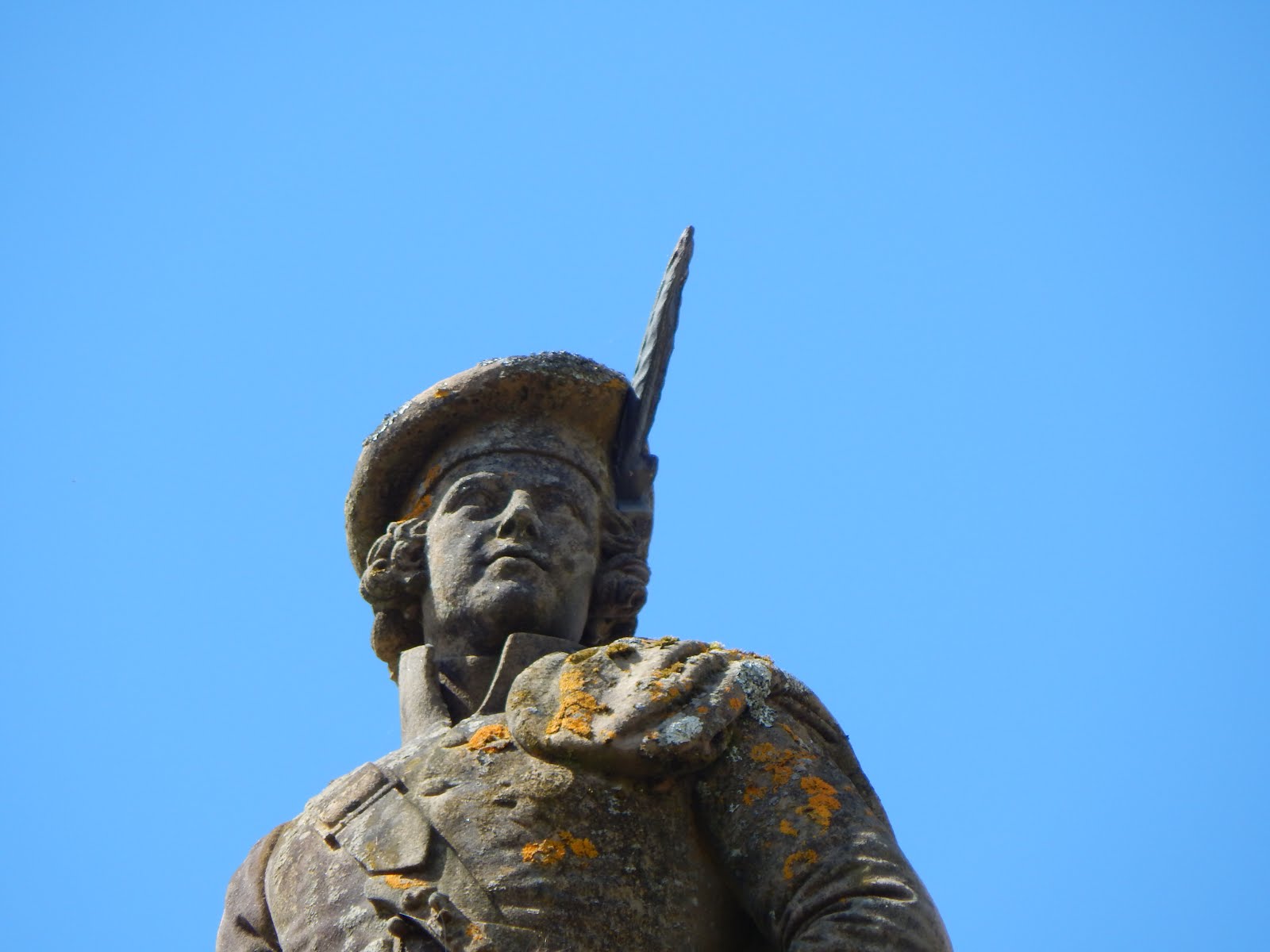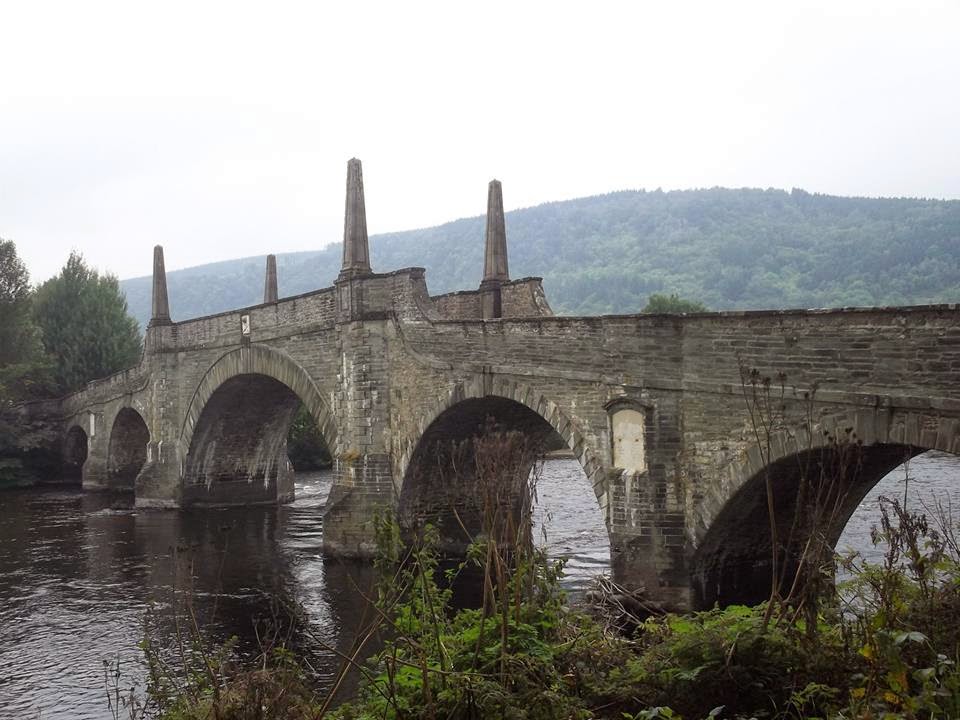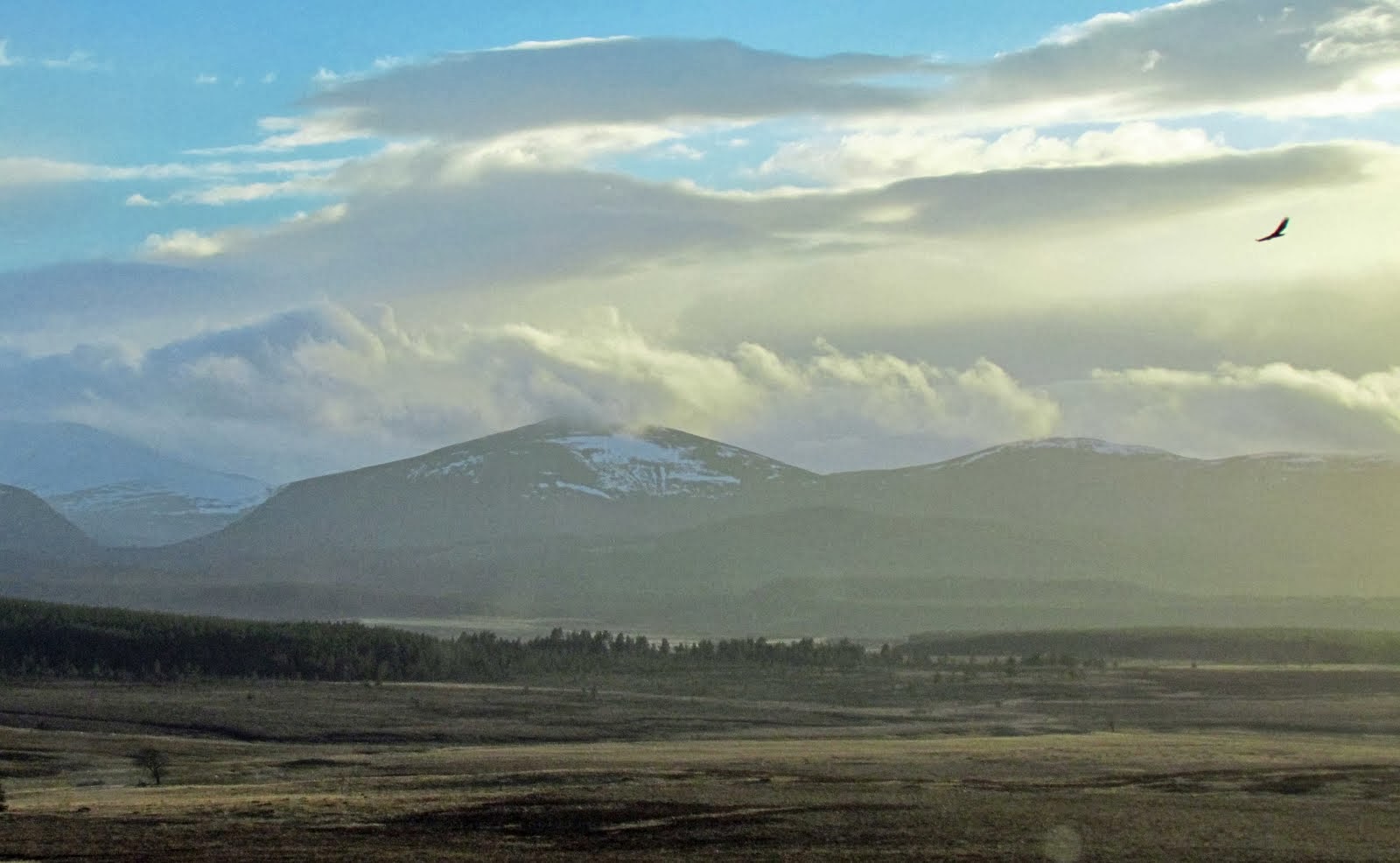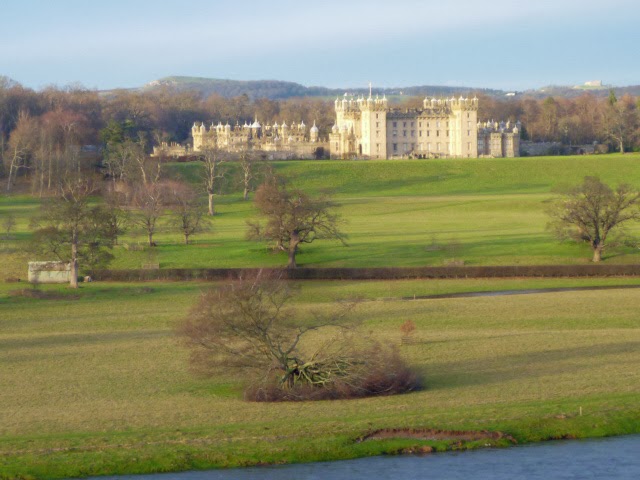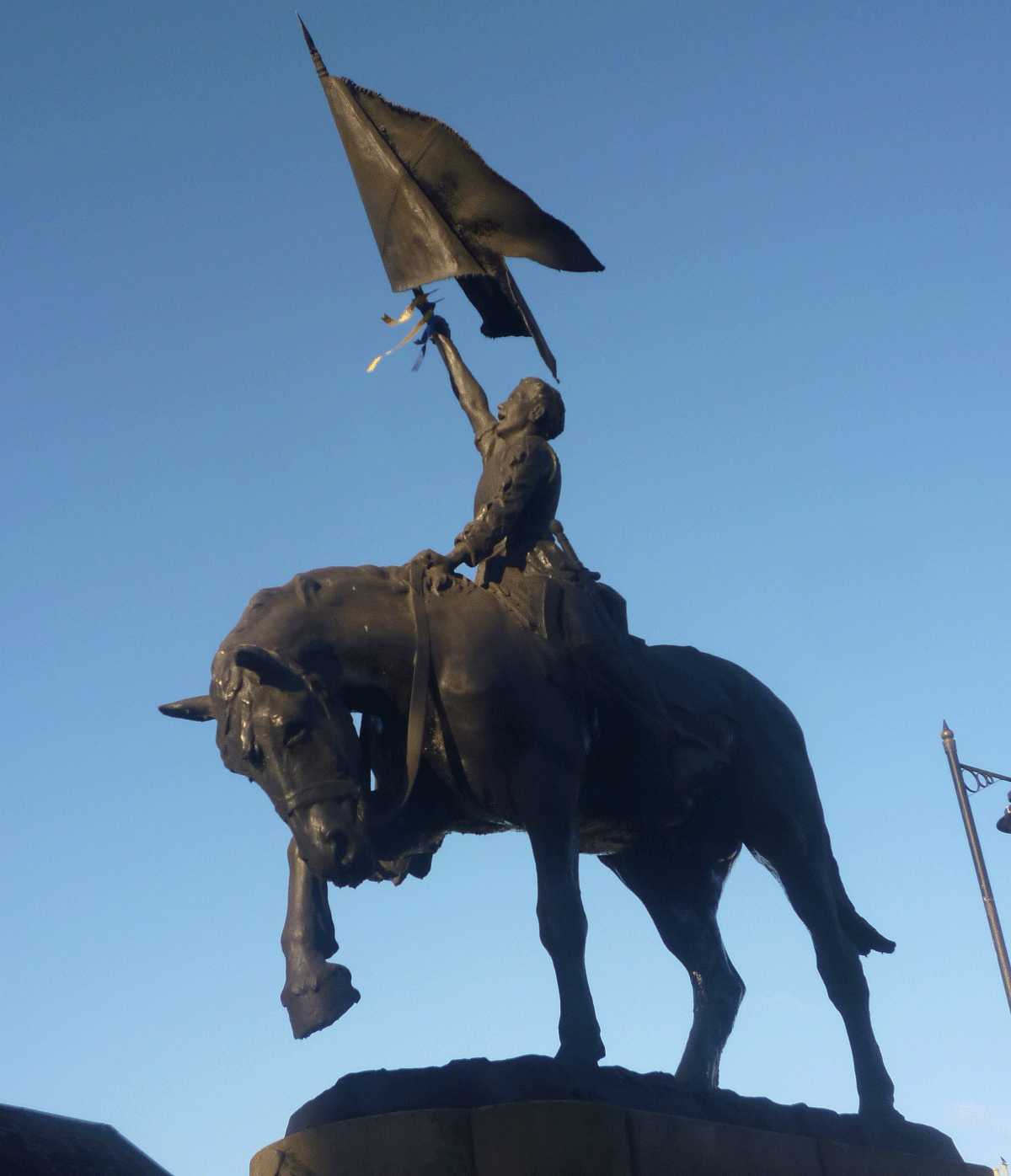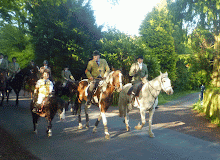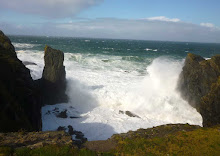The best known Jacobite rising was of course the 1745 which ended with the disastrous Battle of Culloden. But it was the 1715 that had the most chance of success. Queen Anne died in August 1714 and although there were 56 better claimants, a non English speaking (but Protestant) German princeling was brought over to be the next king. Many people were unhappy; there were impromptu riots in English cities and armed rebellions in northern England and Scotland. The rightful king, Bonnie Prince Charlie's father James, took an extraordinarily long time to lend his presence to those who wished to secure the crown for him. Had he come earlier, things might have been different!
James arrived (in disguise) at Peterhead on 23 December 1716 accompanied by just six gentlemen companions. No preparations had been made but he was offered the Earl Marischal's house at Fetteresso near Stonehaven. The Earl himself was in Perth with the Jacobite army, only arriving at Fetteresso on the 27th. The weather was foul and the king fell ill with the ague. He thus spent Christmas, still incognito, ill in bed in a strange, cold, house without a host or hostess (and a price of £100,000 on his head!). I doubt there were many presents.
My broken leg and I are being looked after by the excellent staff at Raigmore hospital, Inverness, this Christmas. It will be a whole lot more pleasant than that of the would-be James VIII of Scotland on his first visit to this country in 1716!
I wish you all a Christmas fit for a king!
PS. For more on Jacobites and Christmas, have a look at my last Christmas post.
Thursday, December 22, 2011
Thursday, November 10, 2011
Remembrance Day
I was delighted to read that traffic in Inverness will stop for two minutes at 11.00 tomorrow, 11 November, to mark the memory of all those servicemen who fell in the First World War and subsequent conflicts. This move which augments tributes that will be paid at War Memorials throughout the land this Sunday is a welcome move to bring this extraordinary sacrifice into people's daily lives.
I was at Eilean Donan Castle recently, looking at the memorial to the MacRaes who gave their lives in the two wars. I re-read the poem by John MacRae, a Canadian, which led to the poppy becoming the emblem of Remembrance:
On the first day of the Battle of the Somme, 1 July 1916, the British Army suffered nearly 60,000 casualties - that's nearly the population of Inverness.
I, too, will be pausing for two minutes at 11.00 tomorrow.
I was at Eilean Donan Castle recently, looking at the memorial to the MacRaes who gave their lives in the two wars. I re-read the poem by John MacRae, a Canadian, which led to the poppy becoming the emblem of Remembrance:
In Flanders fields the poppies grow
Between the crosses, row on row,
That mark our place; whilst in the sky
The larks, still bravely singing, fly
Scarce heard amidst the guns below.
We are the dead. Short days ago
We lived, felt dawn, saw sunset glow,
Loved and were loved and now we lie
In Flanders fields.
We are the dead. Short days ago
We lived, felt dawn, saw sunset glow,
Loved and were loved and now we lie
In Flanders fields.
I, too, will be pausing for two minutes at 11.00 tomorrow.
Saturday, November 05, 2011
Guy Fawkes Day and the 'Winter Queen'
Today is an ideal Guy Fawkes Day - clear, crisp and a Saturday. There will be fireworks throughout the United Kingdom tonight and massive bonfires topped with a 'guy', a stuffed effigy of Guy Fawkes who, on 5 November 1605, hoped to make a bonfire of the Houses of Parliament thereby killing the king.
The king in question was King James VI of Scotland (right), son of Mary Queen of Scots, and recently crowned James I of England. Guy Fawkes and his co-conspirators were aggrieved that James, a Protestant (albeit with a Roman Catholic mother and wife) was not resisting anti-Catholic legislation.
The story twists and turns and is well told here and here. In essence the plot was that with the king and his elder son dead, his nine year old daughter Elizabeth would become Queen of a newly Catholic country. Well, Fawkes was discovered on 4 November and Elizabeth grew up to marry the German Frederick V, Elector Palatinate. For just a few months in the winter of 1619/1620 Frederick became King of Bohemia, and known as 'The Winter King'; thus Elisabeth acquired her moniker 'Winter Queen'.
Elisabeth, who was born in Falkland Palace in Fife and brought up at Linlithgow Palace near Edinburgh, would surely have considered herself a Scot; her portrait hangs in the Scottish National Portrait Gallery. It is therefore doubly ironic that Elizabeth whom Guy Fawkes wished to crown as a Catholic Queen is remembered principally as the Grandmother of George I, who was preferred to the Cathoic James Stuart, the exiled de jure king, when Queen Anne died in 1714. George, a Protestant, became the first monarch of the House of Hanover, leapfrogging more than 50 Roman Catholics who had a better claim to the throne! There followed 32 years of Jacobite Risings, seeking to right this perceived wrong.
Elizabeth died in England, whilst visiting her nephew Charles II who was fond of her and insisted that some of the 'barbarous' names in his new territories across the Atlantic were named after her, hence the Elizabeth River in Southeastern Virginia and Cape Elizabeth in Maine.
Happy Guy Fawkes Day!
The king in question was King James VI of Scotland (right), son of Mary Queen of Scots, and recently crowned James I of England. Guy Fawkes and his co-conspirators were aggrieved that James, a Protestant (albeit with a Roman Catholic mother and wife) was not resisting anti-Catholic legislation.
The story twists and turns and is well told here and here. In essence the plot was that with the king and his elder son dead, his nine year old daughter Elizabeth would become Queen of a newly Catholic country. Well, Fawkes was discovered on 4 November and Elizabeth grew up to marry the German Frederick V, Elector Palatinate. For just a few months in the winter of 1619/1620 Frederick became King of Bohemia, and known as 'The Winter King'; thus Elisabeth acquired her moniker 'Winter Queen'.
Elisabeth, who was born in Falkland Palace in Fife and brought up at Linlithgow Palace near Edinburgh, would surely have considered herself a Scot; her portrait hangs in the Scottish National Portrait Gallery. It is therefore doubly ironic that Elizabeth whom Guy Fawkes wished to crown as a Catholic Queen is remembered principally as the Grandmother of George I, who was preferred to the Cathoic James Stuart, the exiled de jure king, when Queen Anne died in 1714. George, a Protestant, became the first monarch of the House of Hanover, leapfrogging more than 50 Roman Catholics who had a better claim to the throne! There followed 32 years of Jacobite Risings, seeking to right this perceived wrong.
Elizabeth died in England, whilst visiting her nephew Charles II who was fond of her and insisted that some of the 'barbarous' names in his new territories across the Atlantic were named after her, hence the Elizabeth River in Southeastern Virginia and Cape Elizabeth in Maine.
Happy Guy Fawkes Day!
Saturday, October 29, 2011
Shinty/Hurling International
I went down to Bught Park in Inverness today to see an International... Scotland v Ireland playing the hybrid rules that combine Scotland's national game of Shinty with its Irish brother, Hurling.
I once watched a Shinty game with an American client, and remember describing it as hockey with fewer rules. He said, 'Mmmh, strikes me as more like organised violence'. This was what we enjoyed today.
Watching the game, I was struck by the difference in the two sticks. As you can see from this advertisement, the Hurling stick has a flat surface and the Irish proved very skilled at picking up the ball, running with it tossing it up and hitting. The Shinty stick is better suited to hitting off the ground and this was where the Scottish points came from.
The word 'Shinty' probably comes from the Gaelic sinteag, a leap or bound, which may also be the root of the word 'shindig', a riotous party. The first reference to Shinty is actually in Kirk Session records of the City of Glasgow in 1589.
Hurling, probably Shinty's ancestor, has earlier roots: a 12th century Irish document refers to Cuchulainn, a mythological Celtic hero, who won fame by driving a ball into the snarling mouth of a guard dog.
Shinty or Camanachd is a part of Scotland's Gaelic heritage. In the bloody aftermath of the Battle of Culloden in 1746 tartan was banned, carrying weapons was banned, bagpipes were banned and there were attempts to ban both Shinty and Golf (that other Scottish game). But the subsequent Highland Clearances dispersed Highlanders and their Celtic culture all over the world; Shinty spread with them and there is now a US Camanachd Association. Golf seems to have caught on there too.
In Canada, they say, the game changed a little. In 1800 Scottish immigrants played on ice at Windsor; and ice hockey was born.
And what happened today?
Well, it was a bit like the Scottish Rugby team's performance in the recent World Cup in New Zealand: doing well at half time (11 - 5) but ultimate defeat (14 - 15). Both sides played well and there were remarkably few casualties.
I once watched a Shinty game with an American client, and remember describing it as hockey with fewer rules. He said, 'Mmmh, strikes me as more like organised violence'. This was what we enjoyed today.
Watching the game, I was struck by the difference in the two sticks. As you can see from this advertisement, the Hurling stick has a flat surface and the Irish proved very skilled at picking up the ball, running with it tossing it up and hitting. The Shinty stick is better suited to hitting off the ground and this was where the Scottish points came from.
The word 'Shinty' probably comes from the Gaelic sinteag, a leap or bound, which may also be the root of the word 'shindig', a riotous party. The first reference to Shinty is actually in Kirk Session records of the City of Glasgow in 1589.
Hurling, probably Shinty's ancestor, has earlier roots: a 12th century Irish document refers to Cuchulainn, a mythological Celtic hero, who won fame by driving a ball into the snarling mouth of a guard dog.
Shinty or Camanachd is a part of Scotland's Gaelic heritage. In the bloody aftermath of the Battle of Culloden in 1746 tartan was banned, carrying weapons was banned, bagpipes were banned and there were attempts to ban both Shinty and Golf (that other Scottish game). But the subsequent Highland Clearances dispersed Highlanders and their Celtic culture all over the world; Shinty spread with them and there is now a US Camanachd Association. Golf seems to have caught on there too.
In Canada, they say, the game changed a little. In 1800 Scottish immigrants played on ice at Windsor; and ice hockey was born.
And what happened today?
Well, it was a bit like the Scottish Rugby team's performance in the recent World Cup in New Zealand: doing well at half time (11 - 5) but ultimate defeat (14 - 15). Both sides played well and there were remarkably few casualties.
Thursday, October 13, 2011
Queen Victoria's Love of Scotland
I've been working a few weekends recently and, now that the season is over, today I took a day off - a walk down the lovely River Findhorn...
 At Dunkeld the Royal Party was met by the Atholl Highlanders, armed with the Lochaber axe. Received in an immense marquee, they were regaled with a gargantuan menu, a display of Highland sword-dancing and a taste of Atholl Brose. Taymouth Castle took things to a higher level. The firing of the guns," Victoria recorded in her Journal, "the cheering of the great crowd, the picturesqueness of the dresses, the beauty of the surrounding country, with its rich background of wooded hills, altogether formed one of the finest scenes imaginable. Lord and Lady Breadalbane took us upstairs, the hall and stairs being lined with Highlanders". If anything more were needed, dusk brought not only fireworks but 'Welcome Victoria - Albert' spelled out in hundreds of oil lamps, and the blaze of bonfires from a dozen nearby summits" .
At Dunkeld the Royal Party was met by the Atholl Highlanders, armed with the Lochaber axe. Received in an immense marquee, they were regaled with a gargantuan menu, a display of Highland sword-dancing and a taste of Atholl Brose. Taymouth Castle took things to a higher level. The firing of the guns," Victoria recorded in her Journal, "the cheering of the great crowd, the picturesqueness of the dresses, the beauty of the surrounding country, with its rich background of wooded hills, altogether formed one of the finest scenes imaginable. Lord and Lady Breadalbane took us upstairs, the hall and stairs being lined with Highlanders". If anything more were needed, dusk brought not only fireworks but 'Welcome Victoria - Albert' spelled out in hundreds of oil lamps, and the blaze of bonfires from a dozen nearby summits" .
Following the Battle of Culloden in 1746, Queen Victoria's great great grandfather George II had done everything in his power to destroy Highland culture (an undoubted seedbed of Jacobite discontent and a threat to the throne since 1689): the wearing of tartan was banned, the carrying of weapons was banned, the playing of the bagpipes was banned and the clan chiefs were stripped of their power. His son, the Duke of Cumberland thinned out the Highland population considerably and used their cattle to feed his occupying army. You would be forgiven for thinking that Highland culture was beyond saving.
So we should indeed be grateful to the Duke and Duchess of Atholl and Lord and Lady Breadalbane for their wonderful display of Highland hospitality. Without them and the Queen's resulting decision to buy Balmoral Castle unseen, those three great icons of our culture, Tartan, Bagpipes and Whisky, would never now be recognised worldwide.
... and a cup of tea at nearby Logie Steading, where there is a particularly good second hand bookshop. I fell prey to a book on Scottish surnames, a volume of Nigel Tranter's Fortified Houses of Scotland, and the book that has kept me engrossed for the past several hours, Ronald W Clark's Balmoral. No wonder Queen Victoria fell in love with Scotland when she visited first in 1842!
 At Dunkeld the Royal Party was met by the Atholl Highlanders, armed with the Lochaber axe. Received in an immense marquee, they were regaled with a gargantuan menu, a display of Highland sword-dancing and a taste of Atholl Brose. Taymouth Castle took things to a higher level. The firing of the guns," Victoria recorded in her Journal, "the cheering of the great crowd, the picturesqueness of the dresses, the beauty of the surrounding country, with its rich background of wooded hills, altogether formed one of the finest scenes imaginable. Lord and Lady Breadalbane took us upstairs, the hall and stairs being lined with Highlanders". If anything more were needed, dusk brought not only fireworks but 'Welcome Victoria - Albert' spelled out in hundreds of oil lamps, and the blaze of bonfires from a dozen nearby summits" .
At Dunkeld the Royal Party was met by the Atholl Highlanders, armed with the Lochaber axe. Received in an immense marquee, they were regaled with a gargantuan menu, a display of Highland sword-dancing and a taste of Atholl Brose. Taymouth Castle took things to a higher level. The firing of the guns," Victoria recorded in her Journal, "the cheering of the great crowd, the picturesqueness of the dresses, the beauty of the surrounding country, with its rich background of wooded hills, altogether formed one of the finest scenes imaginable. Lord and Lady Breadalbane took us upstairs, the hall and stairs being lined with Highlanders". If anything more were needed, dusk brought not only fireworks but 'Welcome Victoria - Albert' spelled out in hundreds of oil lamps, and the blaze of bonfires from a dozen nearby summits" . |
| Taymouth Castle |
So we should indeed be grateful to the Duke and Duchess of Atholl and Lord and Lady Breadalbane for their wonderful display of Highland hospitality. Without them and the Queen's resulting decision to buy Balmoral Castle unseen, those three great icons of our culture, Tartan, Bagpipes and Whisky, would never now be recognised worldwide.
Saturday, April 16, 2011
265 Years After Culloden
This morning I travelled from my home in Nairn past Balbair where the government army camped prior to the Battle of Culloden, past the Loch of the Clans, past Kilravock Castle where the Duke of Cumberland reputedly had breakfast, and on to the site of that battle, 265 years ago on Drumossie Moor, where I attended the annual commemoration service.
It was perhaps appropriate that I approached from this direction since I am a Lowlander. I served in the British Army, in a regiment that stood in the Government front line that day. But one of my ancestors died fighting with the Jacobites in the 1715 Rising. So, like many Scots, my sympathies are split. I abhor Cumberland's cruelty following that battle. Equally, I condemn the arrogance that led to the whole misconceived enterprise, undertaken with no foreign assistance.
Seventy years earlier the 'Brahan Seer' had written "Oh! Drumossie, thy bleak moor shall, 'ere many generations have passed away, be stained with the best blood of the Highlands. Glad am I that I will not see the day, for it will be a fearful period." And so it was. An awful slaughter, the beginning of the end of the clan system.
As a tour guide, I am often at the battlefield. It's a familiar routine, explaining the battle to visitors. But I have never heard a Gaelic prayer, never heard a Piobaireachd, (the great pipe lament), spreading out over this familiar field. It becomes a different place, especially when surrounded by Highlanders who have been there numerous times before, and will come again, to pay respect.
Surrounded by descendants of those who died, I am even more appalled that for 76 years there were no markers at the mass graves of a thousand or more members of the Jacobite Army who fell that day. It was only in 1822 that Duncan Forbes of Culloden erected the present stones; the great grandchildren of the Inverness women who dug those graves told him which mound was which. It was only some 30 years ago that the 1835 road which bisected the graves was diverted to a discreet distance.
The swallows are recently arrived in Highland farmyards, baby rabbits scuttle on field fringes, skylarks sing over rough pasture and black-faced sheep that have been overwintered on the low ground are heading back to the hills. Just as it was in 1746.
And just as in 1746 Highlanders are dying for a cause that they cannot fully understand, not in the sleet of Drumossie Moor but in the dust of Afghanistan. As Allan Campbell, President of the Gaelic Society of Inverness, commented this morning, 'It is extraordinary that we never learn the folly of war'.
It was perhaps appropriate that I approached from this direction since I am a Lowlander. I served in the British Army, in a regiment that stood in the Government front line that day. But one of my ancestors died fighting with the Jacobites in the 1715 Rising. So, like many Scots, my sympathies are split. I abhor Cumberland's cruelty following that battle. Equally, I condemn the arrogance that led to the whole misconceived enterprise, undertaken with no foreign assistance.
Seventy years earlier the 'Brahan Seer' had written "Oh! Drumossie, thy bleak moor shall, 'ere many generations have passed away, be stained with the best blood of the Highlands. Glad am I that I will not see the day, for it will be a fearful period." And so it was. An awful slaughter, the beginning of the end of the clan system.
As a tour guide, I am often at the battlefield. It's a familiar routine, explaining the battle to visitors. But I have never heard a Gaelic prayer, never heard a Piobaireachd, (the great pipe lament), spreading out over this familiar field. It becomes a different place, especially when surrounded by Highlanders who have been there numerous times before, and will come again, to pay respect.
Surrounded by descendants of those who died, I am even more appalled that for 76 years there were no markers at the mass graves of a thousand or more members of the Jacobite Army who fell that day. It was only in 1822 that Duncan Forbes of Culloden erected the present stones; the great grandchildren of the Inverness women who dug those graves told him which mound was which. It was only some 30 years ago that the 1835 road which bisected the graves was diverted to a discreet distance.
The swallows are recently arrived in Highland farmyards, baby rabbits scuttle on field fringes, skylarks sing over rough pasture and black-faced sheep that have been overwintered on the low ground are heading back to the hills. Just as it was in 1746.
And just as in 1746 Highlanders are dying for a cause that they cannot fully understand, not in the sleet of Drumossie Moor but in the dust of Afghanistan. As Allan Campbell, President of the Gaelic Society of Inverness, commented this morning, 'It is extraordinary that we never learn the folly of war'.
Friday, March 25, 2011
The Clans - violence, honour and obligation
I was listening yesterday to a programme about Easter Island in the South Pacific; the commentator referred to 'rival clans'. Around Christmas in London I was in a taxi driven by a man from Somalia, who talked about the 'clans' who are controlling certain areas there. In both (random) cases there is an implication of violence: the clans in Easter Island finally eliminated one another and uncontrolled 'clans' was the reason that my Somali taxi driver was disinclined to return to his Somaliland home. The violence in 'Klan' is self evident.
My Shorter Oxford Dictionary (pub. 2007) gives four definitions for 'clan'; none has any violent or negative association. I believe that this fine word is now being corrupted.
It comes from the Gaelic clann which simply means 'children'. Clan is in fact a wholly positive word which speaks of honour, of commitment, of people supporting each another. In his excellent book 'Clans & Chiefs' Ian Grimble writes, '...the office...required that the chief should place his undefined patriachal obligations before his absolute feudal rights'. This was fundamental.
There aren't so many examples nowadays of 'undefined obligations' taking precedence over 'absolute rights'. And of course the other side of the coin was that clansmen were absolutely bound to fight and die in any fight that might be picked by the chief.
How wonderful, though, that in 2011 the Standing Council of Scottish Chiefs has a website ... and invites questions. An undefined obligation if ever there was one!
My Shorter Oxford Dictionary (pub. 2007) gives four definitions for 'clan'; none has any violent or negative association. I believe that this fine word is now being corrupted.
It comes from the Gaelic clann which simply means 'children'. Clan is in fact a wholly positive word which speaks of honour, of commitment, of people supporting each another. In his excellent book 'Clans & Chiefs' Ian Grimble writes, '...the office...required that the chief should place his undefined patriachal obligations before his absolute feudal rights'. This was fundamental.
There aren't so many examples nowadays of 'undefined obligations' taking precedence over 'absolute rights'. And of course the other side of the coin was that clansmen were absolutely bound to fight and die in any fight that might be picked by the chief.
How wonderful, though, that in 2011 the Standing Council of Scottish Chiefs has a website ... and invites questions. An undefined obligation if ever there was one!
Saturday, March 05, 2011
Happy Tenth Birthday... to Us!
It was ten years ago that Scottish Clans and Castles Ltd emerged from a mixed bag of other tourism projects.
And I'm delighted to have traced our first client, Angie Anstee (now Eikebu)... "It was 18th April 2001, my Norwegian husband's first trip with me to Scotland and we liked it so much we stayed two nights instead of the one that we booked!" The place, unsurprisingly, was Castle Stuart, an enduring favourite of our clients. And dear Caroline Stuart, the Chatelaine, has just emailed confirming more honeymooners this September.
Then, as now, our clients were primarily looking for holidays tailored to their personal requirements and clan connections. But a couple of years later we ran our first 'Outlander' Tour, a guided trip for fans of Diana Gabaldon's novels. It went well. Of our four clients two re-booked for the following year (and one is now running her own guiding operation in Minnesota). And last year we ran three 'Outlander' tours during one of which our guests dined with Diana Gabaldon and her husband at Castle Stuart.
The Year of Homecoming in 2009 was a milestone for us and about 300 of our clients enjoyed 'The Gathering' in Holyrood Park, Edinburgh.
This year, on our tenth anniversary, we are delighted to be launching two new products - 'Scottish Castle Escapes' and 'The Ultimate Highland Castle House Party', the latter being a luxurious weekend at Aldourie Castle on the banks of Loch Ness with private tours of local castles.
Now then... I'm thinking of a Castle birthday cake, candle on each turret...
And I'm delighted to have traced our first client, Angie Anstee (now Eikebu)... "It was 18th April 2001, my Norwegian husband's first trip with me to Scotland and we liked it so much we stayed two nights instead of the one that we booked!" The place, unsurprisingly, was Castle Stuart, an enduring favourite of our clients. And dear Caroline Stuart, the Chatelaine, has just emailed confirming more honeymooners this September.
Then, as now, our clients were primarily looking for holidays tailored to their personal requirements and clan connections. But a couple of years later we ran our first 'Outlander' Tour, a guided trip for fans of Diana Gabaldon's novels. It went well. Of our four clients two re-booked for the following year (and one is now running her own guiding operation in Minnesota). And last year we ran three 'Outlander' tours during one of which our guests dined with Diana Gabaldon and her husband at Castle Stuart.
The Year of Homecoming in 2009 was a milestone for us and about 300 of our clients enjoyed 'The Gathering' in Holyrood Park, Edinburgh.
This year, on our tenth anniversary, we are delighted to be launching two new products - 'Scottish Castle Escapes' and 'The Ultimate Highland Castle House Party', the latter being a luxurious weekend at Aldourie Castle on the banks of Loch Ness with private tours of local castles.
Now then... I'm thinking of a Castle birthday cake, candle on each turret...
Tuesday, February 01, 2011
"A daimen icker in a thrave"
A family group has just asked me to schedule a visit to Robert Burns birthplace. By coincidence I was there, at the new Burns Museum, last week.
I'm a great fan of Burns and, having been born and bred in Scotland, many words are familiar to me. But for those who do not enjoy that great privilege Burns can be a bit impenetrable! Take a daimen icker in a thrave for example; it's a line from 'To a Mouse'. Who has any idea what that means? (actually it means 'the occasional ear of corn in a set of sheaves').
I visited the museum with some other tour operators and we were inevitably concerned as to whether overseas clients would be able to understand it. The short answer was 'No'. Indeed the National Trust for Scotland has made the whole thing even less penetrable by writing the explanations on the show cabinets in Burnsian Scots, with difficult words translated. Not much good for overseas visitors.
But after a bit I mused that this is a celebration of Burns and his work. Should it not also be a celebration of his language? David Hopes, museum curator said, "Our intention has been to get under the skin of Burns, encouraging a creative response in the reader-visitor." A noble intention, and I think he has succeeded. But how important is the original language?
One translation of Burns into Russian apparently sold over 600,000 copies and Burns is still taught in Russian schools. But I'm sure Abraham Lincoln, who carried a volume of Burns' work with him, only read the original. And what of Steinbeck whose 'Of Mice and Men' was inspired by the ploughman poet and his line from 'To a Mouse': The best laid schemes o' mice an' men / Gang aft agley.'? How did he make sense of it? 'Translated' or not? Well, maybe some scholars can help me with that.
I do not believe that Scots is a language in its own right. But if traditional words and syntax are not used somewhere today, will it only be future academics who can revel in the earthiness and wonderful rhythms of Burns' poetry?
When I had seen the museum I wandered over to the old Brig o' Doon (of Tam o' Shanter fame) and the nearby Burns Monument, where I learned that there are 58 monuments to Burns around the world. Fifty-eight! More than any other poet.
This does not, of course, make him the world's greatest poet but it does convince me that Burns should not be celebrated in translation.
I'm a great fan of Burns and, having been born and bred in Scotland, many words are familiar to me. But for those who do not enjoy that great privilege Burns can be a bit impenetrable! Take a daimen icker in a thrave for example; it's a line from 'To a Mouse'. Who has any idea what that means? (actually it means 'the occasional ear of corn in a set of sheaves').
I visited the museum with some other tour operators and we were inevitably concerned as to whether overseas clients would be able to understand it. The short answer was 'No'. Indeed the National Trust for Scotland has made the whole thing even less penetrable by writing the explanations on the show cabinets in Burnsian Scots, with difficult words translated. Not much good for overseas visitors.
But after a bit I mused that this is a celebration of Burns and his work. Should it not also be a celebration of his language? David Hopes, museum curator said, "Our intention has been to get under the skin of Burns, encouraging a creative response in the reader-visitor." A noble intention, and I think he has succeeded. But how important is the original language?
One translation of Burns into Russian apparently sold over 600,000 copies and Burns is still taught in Russian schools. But I'm sure Abraham Lincoln, who carried a volume of Burns' work with him, only read the original. And what of Steinbeck whose 'Of Mice and Men' was inspired by the ploughman poet and his line from 'To a Mouse': The best laid schemes o' mice an' men / Gang aft agley.'? How did he make sense of it? 'Translated' or not? Well, maybe some scholars can help me with that.
I do not believe that Scots is a language in its own right. But if traditional words and syntax are not used somewhere today, will it only be future academics who can revel in the earthiness and wonderful rhythms of Burns' poetry?
When I had seen the museum I wandered over to the old Brig o' Doon (of Tam o' Shanter fame) and the nearby Burns Monument, where I learned that there are 58 monuments to Burns around the world. Fifty-eight! More than any other poet.
This does not, of course, make him the world's greatest poet but it does convince me that Burns should not be celebrated in translation.
Saturday, January 22, 2011
A Witch's Cursing Bone
It was a familiar voice on the car radio. But until he started talking about ancestry I hadn't recognised Bruce Durie, genealogist, broadcaster and chairman of the Ancestral Tourism Steering Group on which I sit. When he moved on to the cursing bone of Katherine McNure of Glen Shira, I stopped the car to listen.
The 'bone' in question is now in the National Museum of Scotland, Edinburgh. Further illumination is given by this 'Extract from the Proceedings of the Society of Antiquaries of Scotland Vol.78 (1943-1944) pg141:
Witch’s Cursing-bone consisting of the marrow bone of a deer or sheep, stained deep brown by peat, and fixed through a diamond-shaped pice of bog oak. It was formerly the property of a reputed witch living at the head of Glen Shira, Argyll. According to the local tradition,“When the “witch” wanted to “ill will” one of her neighbours, she went out with her bone between sunset and cock-crow and made for the neighbour's croft. She did not go to the dwelling-house, however, but to the hen house and seized the hen that sat next to the rooster (his favourite), thrawed its neck, and poured its blood through the cursing bone, uttering her curses the while.
I am reminded of Isobel Gowdie, from Auldearn, just two miles from here in Nairn, who gave a full and detailed confession of the doings of her coven at her trial in 1662. I have read the full transcript and she seems really quite proud of her doings - even giving the magic spell by which a witch can turn herself into a hare, then back to a witch.
But soon (25 Jan) it is Burns Night and I finish with my favourite witch: 'Nannie' famous for her 'cutty sark', short skirt, in Robert Burns' epic tale, Tam o' Shanter.
Satan is blowing the pipes, the witches are dancing, Tom is captivated, his horse Maggie terrified...
The 'bone' in question is now in the National Museum of Scotland, Edinburgh. Further illumination is given by this 'Extract from the Proceedings of the Society of Antiquaries of Scotland Vol.78 (1943-1944) pg141:
Witch’s Cursing-bone consisting of the marrow bone of a deer or sheep, stained deep brown by peat, and fixed through a diamond-shaped pice of bog oak. It was formerly the property of a reputed witch living at the head of Glen Shira, Argyll. According to the local tradition,“When the “witch” wanted to “ill will” one of her neighbours, she went out with her bone between sunset and cock-crow and made for the neighbour's croft. She did not go to the dwelling-house, however, but to the hen house and seized the hen that sat next to the rooster (his favourite), thrawed its neck, and poured its blood through the cursing bone, uttering her curses the while.
I am reminded of Isobel Gowdie, from Auldearn, just two miles from here in Nairn, who gave a full and detailed confession of the doings of her coven at her trial in 1662. I have read the full transcript and she seems really quite proud of her doings - even giving the magic spell by which a witch can turn herself into a hare, then back to a witch.
But soon (25 Jan) it is Burns Night and I finish with my favourite witch: 'Nannie' famous for her 'cutty sark', short skirt, in Robert Burns' epic tale, Tam o' Shanter.
Satan is blowing the pipes, the witches are dancing, Tom is captivated, his horse Maggie terrified...
'Even Satan glowr'd, and fidg'd fu' fain
And hotch'd and blew wi' might and main
Till first ae caper, syne anither
Tam tint his reason a' thegither
And roars out, "Weel done, Cutty-sark!"
And in an instant all was dark
And scarcely had he Maggie rallied
When out the hellish legion sallied.'
The new Robert Burns Birthplace Museum opened today, 22 January 2011.
I look forward to visiting on Monday and will report back.
Saturday, January 15, 2011
David Hume and Thomas Aikenhead
A man in a toga, 1.5 times life size, sits at the junction of Edinburgh's Royal Mile and George IV Bridge, more interested in his tablet than in St Giles Cathedral opposite - 'the mother church of presbyterianism'.
The man is David Hume, philosopher, historian, civil servant, founding father of the enlightement and one of the most influential Scots of the last millennium. Small wonder that he has no interest in St Giles, for Hume was an aetheist.
The parade will pass the Old Tron Kirk, a little further down the High Street where the 18 year old Aikenhead made a poor joke about the weather, 'I wish right now I were in the place Ezra called hell to warm myself there'. This flippant attitude to the Bible was the lad's undoing. You might call it a fatwa called by Scotland's Lord Advocate and chief law officer, James Stewart, to discourage others from treating the Bible with disrespect. Years later, Hume was utterly apalled.
I am not an aetheist but I may be there on 23 April to celebrate Hume's extraordinary pioneering thinking.
Hope the weather isn't hellish.
Subscribe to:
Posts (Atom)

























